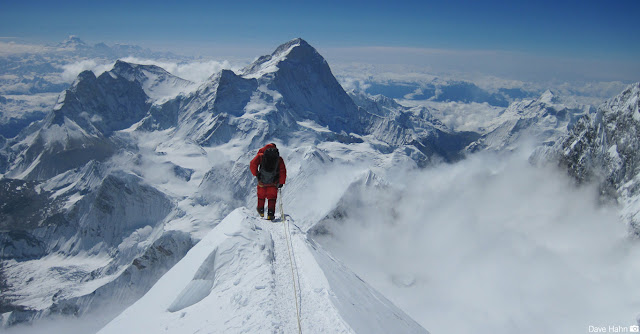Mount Everest
Life on Everest
Mount Everest is surrounded by a number of substantial peaks, including Lhotse, (27,940 feet/8,516 meters); Nuptse, (25,771 feet/7,855 meters); and Changtobse, (24,870 feet/7,580 meters).
Those higher altitudes cannot support animal life or vegetation; however, birch, juniper, blue pines, firs, bamboo and rhododendron grow in the lower areas. There are no plants above 18,690 feet (5,750 meters).
Musk deer, wild yak, red panda, snow leopard and Himalayan black bears inhabit lower altitudes. There are also small numbers of Himalayan thars, deer, langur monkeys, hares, mountain foxes, martens, and Himalayan wolves.
Climbing Mount Everest
Mount Everest attracts experienced mountaineers as well as less-seasoned climbers who typically enlist guides known as sherpas. Climbing more than 8,000 feet is no easy feat. Altitude sickness, weather and wind are the major roadblocks to making the summit for most climbers. More than 5,000 people have climbed Everest and 219 have died trying. About 77 percent of those ascents have been accomplished since 2000. In 2007, a record number of 633 ascents were recorded.
Mount Everest has two main climbing routes, the southeast ridge from Nepal and the north ridge from Tibet. Today, the southeast ridge route, which is technically easier, is more frequently used.
The northern approach was discovered in 1921 by George Mallory during the British Reconnaissance Expedition, which was an exploratory expedition, not intended to attempt the summit. Mallory was famously, perhaps apocryphally, quoted as answering the question "Why do you want to climb Mount Everest?" with the reply "Because it's there."
In 1922, Brit George Finch attempted an ascent using oxygen for the first time, but the expedition was thwarted by an avalanche.
In June 1924, Mallory and Andrew Irvine did not survive their attempt to reach to the summit. A 1999 expedition found Mallory's body.
Early expeditions in the 1920s and 1930s attempted to make the ascent from the Tibetan side but access was closed after Tibet came under Chinese control in 1950. This spurred Bill Tilman and a small party that included Charles Houston, Oscar Houston and Betsy Cowles, to approach Everest through Nepal along the route that has developed into the standard approach to Everest from the south.
In 1952, members of a Swiss expedition led by Edouard Wyss-Dunant, were able to reach a height of about 28,199 feet (8,595 meters) on the southeast ridge, setting a new climbing altitude record. Tenzing Norgay, a member of this expedition and a Nepali sherpa, took part in the British expedition the following year.
In 1953, a British expedition led by John Hunt, returned to Nepal. Hunt selected two climbing pairs to attempt to reach the summit. The first pair (Tom Bourdillon and Charles Evans) came within 300 feet (100 meters) of the summit but were turned back due to oxygen problems. Two days later, the second pair, Edmund Hillary and Tenzing Norgay, reached the summit, took some pictures and left some sweets and a cross.








No comments: